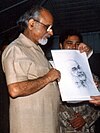Janata Dal
Janata Dal | |
|---|---|
 | |
| Founder | V. P. Singh |
| Founded | 11 October 1988 (1988-10-11) |
| Dissolved | 1999 |
| Merger of | JP, LD, INC(J), JM |
| Succeeded by | JD(S) JD (U) RJD BJD SP LJD |
| National affiliation | National Front (1989-1991) United Front (1996-1998) |
| Colours | Green |
| |
Janata Dal was an Indian political party which was formed through the merger of Janata Party factions, the Lok Dal, Indian National Congress (Jagjivan), and the Jan Morcha united on 11 October 1988 on the birth anniversary of Jayaprakash Narayan under the leadership of V. P. Singh.[1][2]
Contents
1 History
2 Ascent to power
3 Janata Dal Factions
3.1 Pro-NDA Parties
3.2 Pro-UPA Parties
3.3 Non-NDA/UPA Parties
3.4 Defunct Parties
4 New Merger Initiatives
5 References
History
V.P. Singh united the entire disparte spectrum of parties ranging from regional parties such as the Telugu Desam Party, the Dravida Munnetra Kazhagam, and the Asom Gana Parishad, together formed the National Front with N.T.Rama Rao as President and V. P. Singh as convenor with additional outside support from the Bharatiya Janata Party and Communist Party of India (Marxist) led Left front they defeated Rajiv Gandhi's Congress (I) in the 1989 parliamentary elections.[3][4]
His government fell after Lalu Prasad Yadav, arrested Advani in Samastipur and stopped his Ram Rath Yatra which was going to Ayodhya on the site of the Babri Masjid on October 23, 1990 and the Bharatiya Janata Party withdraw support V.P. Singh lost a parliamentary vote of confidence on November 7, 1990.[5]
In the Indian general election, 1991 the Janata Dal lost power but emerged as the third largest party in Lok Sabha.Indian general election, 1991.[6]
Janata Dal-led United Front formed the government after the Indian general election, 1996 with the outside support of the Indian National Congress. But after this the Janata Dal gradually disintegated into various largely regional parties Biju Janata Dal, Rashtriya Janata Dal, Janata Dal (Secular) and Janata Dal (United).[7]
Ascent to power

V. P. Singh
It first came to power in 1989, after allegations of corruption, known as the Bofors scandal, caused Rajiv Gandhi's Congress (I) to lose the elections. The National Front coalition that was formed consisted of the Janata Dal and a few smaller parties in the government, and had outside support from the Left Front and the Bharatiya Janata Party. V. P. Singh was the Prime Minister. In November 1990, this coalition collapsed, and a new government headed by Chandra Shekhar under Samajwadi Janata Party (Rashtriya) which had the support of the Congress came to power for a short while.Two days before the vote, Chandra Shekhar, an ambitious Janata Dal rival who had been kept out of the National Front government, joined with Devi Lal, a former deputy prime minister under V.P. Singh, to form the Samajwadi Janata Party, with a total of just sixty Lok Sabha members. The day after the collapse of the National Front government, Chandra Shekhar informed the President that by gaining the backing of the Congress (I) and its electoral allies he enjoyed the support of 280 members of the Lok Sabha, and he demanded the right to constitute a new government. Even though his rump party accounted for only one-ninth of the members of the Lok Sabha, Chandra Shekhar succeeded in forming a new minority Government and becoming Prime Minister (with Devi Lal as Deputy Prime Minister). However, Chandra Shekhar's government fell less than four months later, after the Congress (I) withdrew its support.

I. K. Gujral
Its second spell of power began in 1996, when the Janata Dal-led United Front coalition came to power, with outside support from the Congress under Sitaram Kesri, choosing H. D. Deve Gowda as their Prime Minister. The Congress withdrew their support in less than a year, hoping to gain power with the support of various United Front constituent groups, and I. K. Gujral became the next Prime Minister. His government too fell in a few months, and in February 1998, the Janata Dal-led coalition lost power to the Bharatiya Janata Party.
Janata Dal Factions
Pro-NDA Parties
Janata Dal (United) led by Nitish Kumar
Lok Janshakti Party led by Ram Vilas Paswan
Rashtriya Lok Samata Party led by Upendra Kushwaha
Socialist Janata Dal led by V. V. Rajendran
Samta Party, party of George Fernandes and now led by Jaya Jaitly and Brahmanand Mandal
Lok Aawaz Dal led by Shambhu Sharan Shrivastava
Rashtriya Samata Party (Secular) led by Arun Kumar
Pro-UPA Parties
Samajwadi Party led by Mulayam Singh Yadav and Akhilesh Yadav
Rashtriya Janata Dal led by Lalu Prasad Yadav
Janata Dal (Secular) led by H. D. Deve Gowda
Rashtriya Lok Dal led by Ajit Singh
Samajwadi Janata Party (Rashtriya), party of Late Chandra Shekhar now led by Kamal Morarka
Hindustani Awam Morcha (Secular) led by Jitan Ram Manjhi
Loktantrik Janata Dal led by Sharad Yadav
Janata Dal (UDF) led by John John
Non-NDA/UPA Parties
Biju Janata Dal led by Naveen Patnaik
Indian National Lok Dal led by Om Prakash Chautala
Samajwadi Secular Morcha led by Shivpal Singh Yadav
Jan Adhikar Party Loktantrik led by Pappu Yadav
Garib Janta Dal (Secular) led by Sadhu Yadav
Odisha Jan Morcha led by Late Pyarimohan Mohapatra
Samata Kranti Dal led by Braja Kishore Tripathy
Loktantrik Samajwadi Party led by Raghu Thakur
Samajwadi Jan Parishad party of Late Kishen Pattanayak and now led by Adv. Kamal Banerjee
Socialist Janata Party led by Manju Mohan
Socialist Party (India) led by Bhai Vaidya
- Socialist Party (Lohia)
Defunct Parties
Samras Samaj Party led by Nagmani (merged with Rashtriya Lok Samata Party) [8]
Socialist Janata (Democratic) Party led by M. P. Veerendra Kumar (merged with Janata Dal (United))[9][10]
Janata Party (merged with Bharatiya Janata Party)[11][12]
National Jan Morcha of Late V. P. Singh and led by Ajeya Pratap Singh (merged with Indian National Congress)
Samajwadi Janata Dal Democratic led by Devendra Prasad Yadav (merged with Janata Dal (United))
Odisha Gana Parishad led by Bijoy Mohapatra (merged with Nationalist Congress Party)
All India Progressive Janata Dal led by Late Ramakrishna Hegde and Late S. R. Bommai (merged with Janata Dal (United))
Janata Dal (Left) led by Late Surendra Mohan and M. P. Veerendra Kumar (merged with Janata Dal (Secular))
Lok Shakti led by Late Ramakrishna Hegde (merged with Janata Dal (United))
Kerala Janata Dal led by Late Arangil Sreedharan (merged with Janata Dal (Secular))
Janata Dal (Gujarat) led by Late Chimanbhai Patel and Late Chhabildas Mehta (merged with Indian National Congress)
Janata Dal (Digvijay) led by Digvijay Singh (merged with Bharatiya Janata Party)
Janata Dal (Ajit) led by Ajit Singh (merged with Indian National Congress)
Janata Dal (Socialist) led by Late Chandra Shekhar, Devi Lal, Mulayam Singh Yadav (renamed as Late Samajwadi Janata Party (Rashtriya))- Punjab Janata Morcha (PJM), in English the Punjab Popular Front, was a Sikh political party in the Indian state of Punjab. The party formed in 1989 as a splinter group of the Janata Dal. The party failed to win any election seats in its lifetime. Party president Kirpal Singh announced that the PJM was disbanded in 1997. Most members joined the Jan Morcha by 2003.[13]
New Merger Initiatives
1. There is a move for the merger of Samta Party, Socialist Janata Dal of V. V. Rajendran, Odisha Jan Morcha, and Lok Aawaz Dal with Janata Dal (United).
2. There is a move for the merger of Hindustani Awam Morcha (Secular), Jan Adhikar Party of Pappu Yadav and Garib Janta Dal (Secular) of Sadhu Yadav with Rashtriya Janata Dal.
3. There is a move for the merger of Samajwadi Secular Morcha with Samajwadi Party.
4. There is a move to united seven parties to form a Bharatiya Samajwadi Party - Samajwadi Janata Party (Rashtriya), Samajwadi Jan Parishad, Socialist Janata Party led by Manju Mohan, Socialist Party (India), Socialist Party (Lohia), Loktantrik Samajwadi Party, and Samata Kranti Dal of Braja Kishore Tripathy.
References
^ N. Jose Chander (1 January 2004). Coalition Politics: The Indian Experience. Concept Publishing Company. pp. 35–. ISBN 978-81-8069-092-1. Retrieved 31 October 2015..mw-parser-output cite.citation{font-style:inherit}.mw-parser-output q{quotes:"""""""'""'"}.mw-parser-output code.cs1-code{color:inherit;background:inherit;border:inherit;padding:inherit}.mw-parser-output .cs1-lock-free a{background:url("//upload.wikimedia.org/wikipedia/commons/thumb/6/65/Lock-green.svg/9px-Lock-green.svg.png")no-repeat;background-position:right .1em center}.mw-parser-output .cs1-lock-limited a,.mw-parser-output .cs1-lock-registration a{background:url("//upload.wikimedia.org/wikipedia/commons/thumb/d/d6/Lock-gray-alt-2.svg/9px-Lock-gray-alt-2.svg.png")no-repeat;background-position:right .1em center}.mw-parser-output .cs1-lock-subscription a{background:url("//upload.wikimedia.org/wikipedia/commons/thumb/a/aa/Lock-red-alt-2.svg/9px-Lock-red-alt-2.svg.png")no-repeat;background-position:right .1em center}.mw-parser-output .cs1-subscription,.mw-parser-output .cs1-registration{color:#555}.mw-parser-output .cs1-subscription span,.mw-parser-output .cs1-registration span{border-bottom:1px dotted;cursor:help}.mw-parser-output .cs1-hidden-error{display:none;font-size:100%}.mw-parser-output .cs1-visible-error{font-size:100%}.mw-parser-output .cs1-subscription,.mw-parser-output .cs1-registration,.mw-parser-output .cs1-format{font-size:95%}.mw-parser-output .cs1-kern-left,.mw-parser-output .cs1-kern-wl-left{padding-left:0.2em}.mw-parser-output .cs1-kern-right,.mw-parser-output .cs1-kern-wl-right{padding-right:0.2em}
^ India Since Independence: Making Sense of Indian Politics. Pearson Education India. 2010. pp. 334–. ISBN 978-81-317-2567-2. Retrieved 31 October 2015.
^ "V. P. Singh, a Leader of India Who Defended Poor, Dies at 77". New York Times. 29 November 2008. Retrieved 31 October 2015.
^ Indian Parliamentary Democracy. Atlantic Publishers & Dist. 2003. pp. 124–. ISBN 978-81-269-0193-7. Retrieved 1 November 2015.
^ "India's Cabinet Falls as Premier Loses Confidence Vote, by 142-346, and Quits". New York Times. 8 November 1990. Retrieved 1 November 2015.
^ "INDIA Parliamentary Chamber: Lok Sabha ELECTIONS HELD IN 1991". Inter-Parliamentary Union. Retrieved 1 November 2015.
^ "Lalu green signal for Janata Parivar unity". Madan Kumar. The Times of India. 5 April 2015. Retrieved 1 November 2015.
^ "Samras Samaj Party merges into RLSP". News.webindia123.com. Retrieved 22 September 2018.
^ "Nitish Kumar hails SJD's merger with JD-U in Kerala : South, News - India Today". Indiatoday.intoday.in. 2014-12-29. Retrieved 2017-03-12.
^ "SJD Merges with Sharad Yadav's Janata Dal (United)". The New Indian Express. 2014-12-29. Retrieved 2017-03-12.
^ "Swamy merges Janata Party with BJP". The Hindu. Retrieved 2017-03-12.
^ "Subramanian Swamy's Janata Party merges with Bharatiya Janata Party". Ndtv.com. 2013-08-11. Retrieved 2017-03-12.
^ "From Lucknow to Delhi, parties that died with their founders". The Indian Express. 24 December 2016. Retrieved 27 June 2018.
